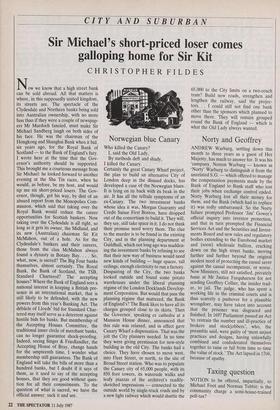Norwegian blue Canary
Who killed the Canary?
I, said the Old Lady, By methods deft and shady, I killed the Canary. . . .
Certainly the great Canary Wharf project, the plan to build an alternative City of London deep in the disused docks, has developed a case of the Norwegian blues. It is lying on its back with its beak in the air. It has all the telltale symptoms of an ex-Canary. The two investment banks whose idea it was, Morgan Guaranty and Credit Suisse First Boston, have dropped out of the consortium to build it. They will, they say, still take space in it. I do not think their promise need worry them. The clue to the murder is to be found in the existing City, and in the planning department at Guildhall, which not long ago was madden- ing the investment banks by refusing to see that their new way of business would need new kinds of building — huge spaces, tall ceilings, enough electricity to run a factory.
Despairing of the City, the two banks looked outside and found some potato warehouses under the liberal planning regime of the London Docklands Develop- ment Corporation. But would that pass the planning regime that mattered, the Bank of England's? The Bank likes to have all its charges grouped close to its skirts. Then the Governor, speaking ex cathedra at a Mansion House dinner, announced that this rule was relaxed, and in effect gave Canary Wharf a dispensation. That was the jolt the City planners needed. In no time they were giving permission for new-style building in the old City. The banks had a choice. They have chosen to move west, into Fleet Street, or north, to the site of Broad Street station. Who was to populate the Canary city of 65,000 people, with its 850 foot towers, its waterside Walks and leafy piazzas of the architect's readily- sketched impressions — connected to the outside world by single-track roads and by a new light railway which would shuttle the 65,000 to the City limits on a two-coach tram? Build new roads, strengthen and lengthen the railway, said the projec- tors. . . I could still not find one bank other than the sponsors which planned to move there. They will remain grouped round the Bank of England — which is what the Old Lady always wanted.


















































 Previous page
Previous page